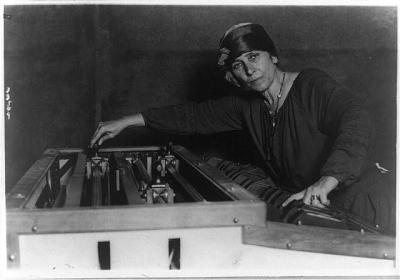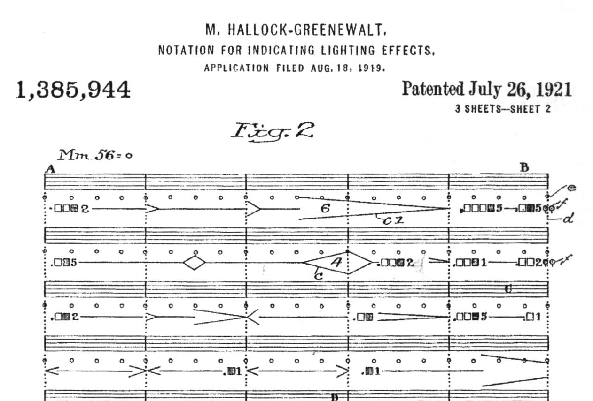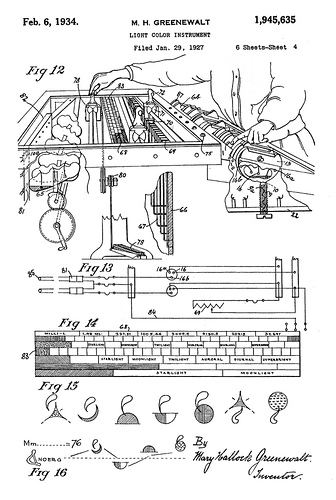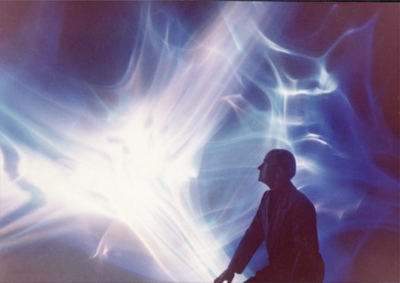|
An Excerpt from The History of Motion Graphics: Between 1919 and 1927 Mary Hallock-Greenewalt (1871 � 1951) filed eleven patents, primarily containing innovations in electrical lighting, while performing as a piano soloist with both the Philadelphia and Pittsburgh symphony orchestras. Some of these patents describe complex systems of electrically switched lights, remote controlled motors that can switch filters and change gobos in lamps, and a central switching board capable of manipulating all the lamps at the same time. Her various patents were formal descriptions of the elements (including a system of notation based on scores for music) that created a new, technological art form. These components were all created to produce the carefully orchestrated graduations of colored light that are the foundation of her system of visual music, which she named �Nourathar��a combination of Arabic words meaning �essence of light.�
 What is especially notable about her instrument for performing this light music, the �Sarabet� (named in honor of her mother Sarah Beth), is that even though trained and employed as a concert pianist, Hallock-Greenewalt did not employ the piano keyboard as the basis for her control system, instead designing a table-sized interface with slider bars and thumb dials to control her lighting system. These sliders would show the intensity of light against a graduated scale. Any lamp could be switched on at any level of brightness. The illumination could be adjusted by directly moving the sliders, through use of a pedal, and with toggle-switches that worked like individual keys. The resulting illumination allowed a continuous adjustment from none to full.
The Sarabet underwent continuous refinement and tinkering, with the various improvement and modifications resulting in four discrete patents for the different variations in her design. Because it was an electro-mechanical system, setting it up for a performance would often require modifications and significant changes to the placement and number of lamps in order to achieve a full coverage of the performance space�s architecture and the geometry of the concert hall. The Sarabet enabled the central control and adjustment of the network of lights in two ways: (1) the 1500 watt lights were controlled based on three increments of light intensity; (2) each lamp used a motorized color wheel capable of changing colors drawn from the entire spectrum: violet, blue, green, yellow, orange and red filters, but these lamps did not otherwise employ filtering of any kind, relying on the graduated fades and direct switching on and off to achieve its effects. The mixture of hues would happen as the light played across the surface of the architectural space or screen. 
In patent no. 1,385,944, she proposed a scoring system for Nourathar that was adapted from music notation. The purpose of this system was to enable repeat performances of the same work of Nourathar; at the same time, it also facilitated the synchronization of these performances with orchestral music. The notations corresponded to the design and markings on the Sarabet�s control system.
This scoring system corresponds to the aesthetics of Nourathar: it was broken into three banks of light corresponding to the physical lamp placement throughout the performance space�front, center and rear. Since her performances often happened in movie theaters and used the movie screen, this division could equally be �top, middle, bottom.� The notations also identify varying levels of illumination, with corresponding intensities: starlight, moonlight, twilight, auroral, diurnal and superbright.
Nevertheless, the Sarabet is a typical example of how the electro-mechanical devices constructed during this period were engineering in the direct service of a specific system of aesthetics; the aesthetics of the work are literally built into the machine itself. The decisions about what types of relationships between sound and image are acceptable must be made by the artist a priori to the construction of the device: in the case of the Sarabet and Nourathar, it is an aesthetic based upon the gradual and nuanced play of colored light, but does not involve the projection of imagery or forms in motion. This is an important distinction between Hallock-Greenewalt�s art of Nourathar and Thomas Wilfred�s Lumia, which was built around the projection of abstract forms in motion.
The emphasis in Nourathar is the unmodulated use of light in architectural space�the play of colored light across the smooth expanse of an arched or domed space, often accompanied by music. These performances were environmental, rather than image or symbol-based. While it is possible for the lamps developed by Hallock-Greenewalt to use gobo filters to give shape the light, she did not develop this potential�instead, she focused on fields of color, more like some of the abstract expressionist painters who were to follow, decades later. Nourathar is an early example of architectural lighting being used aesthetically, and as a result, its influence on motion graphics is primarily through Hallock-Greenewalt�s technological innovations, rather than aesthetics.
Significantly, Hallock-Greenewalt recognized that there is no relationship between color and music unlike many of her contemporaries. Her recognition that color does not have an octave, and that the choices being made to synchronize color and sound were arbitrary, guided by the taste of the composer/performer reveal the significance she has for the emergence of a visual, rather than color, music. Her central recognition in the aesthetics of Nourathar was that the harmonic mixing of sound does not have a parallel with light, which additively combines to produce new, independent colors, rather than musical harmony. Her development of the rheostat is connected to her solution to this divergence between sound and light: the different tonal values of sound find an analogue in the light-to-dark scale of light intensity. The Sarabet would not allow any two colors to be shown at the same intensity at the same time. Each position in her scale allowed for only one lamp to be at that level at a time, thus building Nourathar�s aesthetic of tonal values into the mechanics of the Sarabet. 
The central element of Nourathar, the graduated play of light, required the development of a new type of lighting control: the �rheostat,� which enabled Hallock-Greenewalt to fade the lamps from full intensity to darkness. Closely related to this ability to control tonal values was the mercury switch invented to prevent the noise from the remote controlled electrical contacts that turned lamps on and off, thus enabling the use of her Sarabet in orchestral and concert settings without interfering in performance of the music. Both of these patented innovations were almost immediately stolen by both Westinghouse and Edison companies for use in their theatrical lighting divisions.
These patents were so revolutionary for lighting control that they were almost immediately stolen for use in theatrical lighting manufactured by General Electric. She sued them for patent infringement, but the first judge for her case could not believe that Mary Hallock-Greenewalt, a woman, could have invented so complex and difficult an electrical device as the rheostat. His opinion was overturned on appeal, and Hallock-Greenewalt won this suit.
Following her success with the first suit, she sued another visual music artist, Thomas Wilfred (1889 � 1968), for infringing her patent (no. 1,345,168/revision 16,825) on a system for connecting light and music that she filed in 1916 and received in 1927. This first device employed a hand-painted film that would be viewed in much the same way as one of Edison�s Kinetoscopes�by looking directly down, into the machine, at the film strip itself as it passes over the light�and did not involve projected imagery at all. As in her later scoring system, the notation and timing on these film strips is musical, 4:4 time, rather than the intermittent sampling of 24fps common to motion pictures. The light that would come out of the machine, playing across the wall above it, would have resembled the unmodulated play of light common to later examples of Nourathar. 
Thomas Wilfred with Vertical Sequence, Opus 132 (1941)
However, her suit against Wilfred for infringement is not surprising given the technical design of his instruments. The desire for primacy of invention is a common feature of all these inventors, both in their claims and in their responses to critics looking at what they have built and recognizing similarities between it and those of others. Wilfred�s objections to his Lumia being identified as a type of �mobile graphics� makes the similarity between the Clavilux and the Sarabet clear; at the same time, his objections to the term �mobile graphics� suggests sophistry:
We may aptly apply Mr. Blake�s new term �Mobile Graphics� to the motion painting process�the abstract and non-objective film and the animated cartoon�but the term does not apply to Lumia if we are to accept Webster�s definition of the word Graphics, because the Lumia composer neither paints nor draws his composition�he records it in a special notation, akin to musical notation. This notation�letters and numbers on vertical staffs�is placed on the rack over the Clavilux keyboard and the player then performs the composition by moving the sliding form, color and motion keys as the notation indicates. He has the same latitude for personal interpretation of the composer�s work as the pianist has in music. Optical elements are actuated in a battery of projectors, and the composition takes visual form for the first time as the rays of light from the projectors reach the screen surface.
[Michael Betancourt, ed. Thomas Wilfred's Clavilux, (Holicong: Wildside Press, 2006), pp. 33-34.]
Falling back on a dictionary definition as the basis for rejecting a general description of Wilfred�s work is, almost by definition itself an example of sophistry. Nevertheless, it is the description of the Clavilux that is of greater interest in this discussion: the instrument consists of a series of lamps that are controlled from a central board composed, not of �keys� as Wilfred calls them, but slider bars. The similarities between the Sarabet and the Clavilux continue: the lights are fully remote controlled from this central board, and the composition is written out as a series of discrete instructions based on a model derived from musical notation! While Wilfred�s system and Mary Hallock-Greenewalt�s are examples of a convergent process�both share a common foundation in orchestral performance, and their devices are a response to the same context that produced other abstraction generally and color music variants in particular�the lawsuit against Wilfred also has an inevitable quality to it since he was directly competing with Hallock-Greenewalt for concert venues.
But because his defense to her lawsuit focused on aesthetics, rather then solely on technology, and because it is difficult to entirely separate the aesthetic demands that drove the technical innovations from those inventions, she lost this second suit precisely because Nourathar does not involve the projection of form. Her patent was amended in 1934 to include a disavowal of the �use of stereoscopically focused images such as are known as painted pictures and the like, projected between lenses as distinguished from the substantially shapeless flood of light,� direct evidence of her lost suit against Wilfred.
|

|